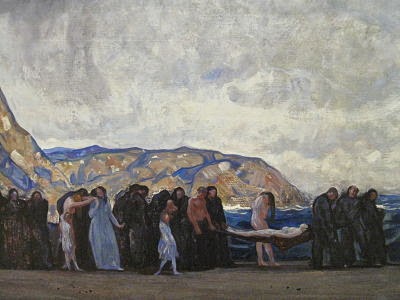Whitfield Lovell (b. 1959), Kin XLVIII (Life is But a Dream), 2011, Conte on paper and metal hard mirror, private collection/Photo by Patricia Leslie
Sunday is the last day to see two extraordinary, contemporary exhibitions at The Phillips Collection: Whitfield Lovell: The Kin Series and Related Works and Jacob Lawrence's Migration Series, the latter which includes all 60 panels brought together from the collections at The Phillips and the Museum of Modern Art.
Lovell, the recipient of a MacArthur Foundation "genius" grant in 2007, has a worldwide reputation for drawing anonymous African-American portraits from photographs and placing them with everyday objects in settings whose times range from the Emancipation Proclamation issued by President Abraham Lincoln on September 22, 1862 to the Civil Rights Movement of the 1960s.
Whitfield Lovell (b. 1959), Dawn to Dawn, 2006, charcoal on wooden barn door and found objects, courtesy DC Moore Gallery/Photo by Patricia Leslie.
The label copy for Dawn to Dawn reads in part: "I like making installations because the sculptural elements thrust the figures into the viewer's physical space--something that I find difficult to do in painting." The wooden background was not constructed for the art, but the art was constructed using found wood, one of many examples which Lovell utilizes to make renderings of people, places, things, and humanity.
If anyone ever questioned the value of an arts education in school, Lovell is proof of its benefits. While a teenager, he attended several art programs which included a spiritual experience at the Prado in Madrid when he was 18.
Wikipedia quotes pages from Lippard, Hanzal, King-Hammond and Way's The Art of Whitfield Lovell: Whispers from the Walls, 2003:
...While I was standing in front of a Velasquez painting I had an amazing spiritual experience. The painter had communicated with me through centuries and cultures, and I suddenly understood the role of the artist. I ran from room to room. Goya, El Greco, Reubens, and Picasso all began to speak out to me. Whatever they were doing in those rooms was what I wanted to do with my life.Whitfield Lovell (b. 1959), Bleck, 2008, Conte crayon on wood and boxing gloves, courtesy, DC Moore Gallery/Photo by Patricia Leslie
Whitfield Lovell (b. 1959), Kin I (Our Folks), 2008, Collection of Reginald and Aliya Browne/Photo by Patricia Leslie. The white slivers on the face and hat are reflections of light on the glass.
The piece above was the first of Lovell's "Kin" series, individual portraits which now number 60. The wall label says the flags beneath the young man are indicative of the complex relationship blacks have with their homeland, created eight years before Colin Kaepernick almost became a household name.
Whitfield Lovell (b. 1959), Whispers: Rising River Blues, 1999, charcoal on wood and found objects, courtesy, DC Moore Gallery/Photo by Patricia Leslie
In the Phillips gallery, the tableau above faces the one below with the clothes strategically placed by Mr. Lovell, a curator said. While in residency in Denton, Texas, the artist studied Quakertown, a black community in the center of Denton which existed from 1875 until 1924 until it was torn asunder because of proximity to a nearby white girls school. The scattered clothing reflects the upheaval families faced, forced to move. Mr. Lovell studied thousands of faces at the Texas African American Photography Archive to capture his lasting impressions which he placed on wood for these two pieces. On the phonograph player above, repetitious, soft music plays continuously.
Whitfield Lovell (b. 1959), Whispers: Mattie When You Marry, 1999, charcoal on wood and found objects, courtesy, DC Moore Gallery/Photo by Patricia Leslie
Whitfield Lovell, Kin XLV (Das Lied von der Erde), 2008 or 2011, Conte on paper with string of pearls, Phillips Collection, Dreier Fund for Acquisitions, 2013/Photo by Patricia Leslie
Whitfield Lovell, b. 1959, After an Afternoon, 2008, courtesy, DC Moore Gallery/Photo by Patricia Leslie
Whitfield Lovell (b. 1959), Everything, 2004, Private collection, courtesy, DC Moore Gallery/Photo by Patricia Leslie
What: Whitfield Lovell: The Kin Series and Related Works
When: Through January 8, 2017, 10 a.m.- 5 p.m., with extended hours on Thursday until 8:30 p.m., and Sunday, 12 - 7 p.m.
Where: The Phillips Collection, 1600 21st St., N.W. at Q St., Washington, D.C. 20009
Admission: $12, $10 for students and those over 62, free for members and for children 18 and under. Ticket includes admission to all exhibitions on view including People on the Move: Beauty and Struggle in Jacob Lawrence's Migration Series
Metro Station: Dupont Circle (Q Street exit. Turn left and walk one block.)
For more information: 202-387-2151
Patricialesli@gmail.com

















+Entrance+to+the+Public+Gardens+in+Arles,+1888,+The+Phillips+Collection.jpg)

+Van+Gogh_s+Bedroom+in+Arles,+1889,+Mus%C3%83%C2%A9e+d_Orsay,+Paris_opt.jpg)
+Lullaby+Madame+Augustine+Roulin+Rocking+a+Cradle+(La+Berceuse),+1889,+Museum+of+Fine+Arts,+Boston.jpg)


